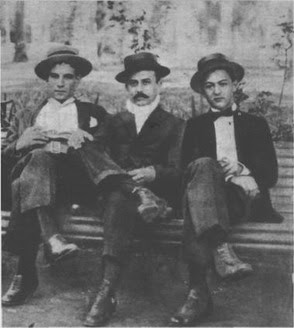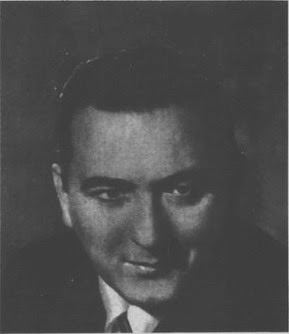 Angel Vargas en 1945
Angel Vargas en 1945 En 1947, ya desvinculado de D'Agostino debutó Vargas con acompañamiento orquestal dirigido y arreglado por Eduardo del Piano, Rodean a ambos, Aldo Campoamor, Roberto Rufino, Raúl Berón, Héctor Insúa, Astor Piazzolla, Armando Pontier, José Rótulo.
En 1947, ya desvinculado de D'Agostino debutó Vargas con acompañamiento orquestal dirigido y arreglado por Eduardo del Piano, Rodean a ambos, Aldo Campoamor, Roberto Rufino, Raúl Berón, Héctor Insúa, Astor Piazzolla, Armando Pontier, José Rótulo. Angel Vargas(derecha) con dos amigos en 1920
Angel Vargas(derecha) con dos amigos en 1920 Angel Vargas
Angel VargasVARGAS, Ángel. (Nombre de familia: JoséLomio). Cantor. Nació en Buenos Aires, barriada del Parque Patricios el 22 de octubre de 1904. Se inició cantando en cines de su barrio. Ingresó más tarde a la orquesta Landó-Matino en el café Marzotto de Corrientes; en 1931 a la de José Luis Padula y el cuarteto de Armando Consani. Ya por entonces había plasmado su particular estilo vocal en algo semejante al de Santiago Devin e influido por ciertos aspectos de la modalidad de Ignacio Corsini. Como solista, con acompañamiento de guitarras,grabó dos fases de disco para Víctor, con el tango La bruja, en una, y el Miíongón de Canaro y Manzi en la otra. Perteneció, desde 1932 como vocalista, a la orquesta de Ángel D'Agostino, formando un cartel artístico de sólido y prolongado apogeo, grabando para Víctor realizaciones tan representativas de su inconfundible modo vocal
como A pan y agua, Viejo coche, Tres esquinas, No vendrás, Palais de Glace, El cuarteador, Menta y cedrón, Ninguna. Se independizó —fugazmente— en 1944, de Alfredo Attadía, y de modo definitivo en 1947, confiando sucesivamente la dirección de su acompañamiento a Eduardo Del Piano, Armando Lacava, Toto D'Amario, Luis Stazo y José Libertella. Falleció en Buenos Aires, ei 7 de julio de 1959.Fuente Horacio Ferrer
Biografia II
Posiblemente, junto a Francisco Fiorentino, fue el modelo del "cantor de la orquesta" Tanto es así que hablar de Angel Vargas nos remite indefectiblemente a Ángel D'Agostino, el director de la orquesta de sus grandes éxitos.
Cantor de una personalidad impresionante, es el símbolo del fraseo porteño de los años cuarenta. Vargas canta como únicamente se cantó en el cuarenta.
Su fraseo era reo y compadrito pero al mismo tiempo, de un infinito buen gusto. Tenía una dulzura que disimulaba su voz pequeña pero varonil, transmitía simpatía y era sobretodo, un cantor carismático.
La dupla D'Agostino-Vargas, es a mi juicio uno de los engranajes más perfectos que nos dio el tango, sólo comparable a la de Troilo con "Fiore".
Su carrera comienza en los inicios de la década del treinta. Actúa en la orquesta del famoso y veterano músico Augusto Pedro Berto, con el seudónimo Carlos Vargas con la que se presentaba en algunas emisoras porteñas. En 1932 realiza algunas presentaciones con quien, tiempo después formaría el binomio del éxito: Ángel D'Agostino.
José Luis Padula, autor del famoso tango "Nueve de julio", lo contrata en 1935 y graban dos temas, el tango "Brindemos compañero" y la ranchera "Ñata linda". En 1938 hace algunos estribillos para la famosa Orquesta Típica Victor y al año siguiente graba dos temas con acompañamiento de guitarras, el tango "La bruja" y "Milongón".
En 1940 comenzará su etapa fundamental al ingresar a la orquesta del pianista Ángel D'Agostino junto a quien permanecerá hasta 1946, dejando 94 temas en el disco, que constituyen verdaderas joyas del género.
Su etapa como solista la encara formando su propia orquesta, alternativamente dirigida por distintos músicos: el bandoneonista Eduardo Del Piano, el pianista Armando Lacava, y los bandoneonistas Edelmiro "Toto" D'Amario, Luis Stazo y José Libertella, en total deja registrado junto a su orquesta un total de 86 temas. También hizo interesantes grabaciones con el trío de Alejandro Scarpino.
Entre sus discos se destacan las interpretaciones de los tangos "No aflojés", "Tres esquinas", "Ninguna" y "Muchacho", el vals "Esquinas porteñas", todos con la orquesta de Angel D'Agostino y, ya en su etapa solista el tango "Ya no cantas chingolo (Chingolito)" de Antonio Scatasso y Edmundo Bianchi, acompañado por su orquesta dirigida por Armando Lacava, que tiene la particularidad doble de ser su único registro en dúo con otro cantante y que además este cantante era su hermano Amadeo Lomio.
Angel Vargas murió joven y todavía sin declinar sus condiciones interpretativas, fue sin duda uno de los más grandes artistas de nuestro tango.Fuente Garcia Blaya de Todotango
In English
Vargas, Angel. (Family name: JoséLomio). Cantor. Born in Buenos Aires neighborhood of Parque Patricios the October 22, 1904. He started singing in his neighborhood cinemas. Later joined the orchestra in the land-Matino coffee Marzotto of Corrientes in 1931 to Jose Luis Padula and the quartet Armando Consani. Already by then had expressed his particular vocal style into something akin to Santi -
Devin go and influenced by certain aspects of the modality Ignacio Corsini. As a soloist, with guitar accompaniment,
recorded two phases of disk for Victor, with tango The witch, in one, and Miíongón Canaro and Manzi in the other. He belonged, dis -
in 1932 as vocalist, the orchestra Angelo D'Agostino, forming a poster art sound and long swing, recorded for Victor achievements as representative of his unmistakable voice mode
For as bread and water, old car, three corners, not come, Palais de Glace, The cuarteador, Mint and cedrón, None. It was independent-fleetingly-in 1944, Alfredo Attadía, and so definitive in 1947, relying on the leadership of its accompanying Eduardo Del Piano, Armando Lacava, Toto D'Amario, Jose Libertella and Luis Stazo. He died in Buenos Aires, ei 7 July 1959.Fuente Horacio Ferrer
Biography II
Possibly, with Francisco Fiorentino, was modeled after "orchestra singer" So much so that talk of Angel Vargas us unfailingly refers to Angelo D'Agostino, the director of the orchestra of their greatest hits.
Singer an impressive personality, is the symbol of Buenos Aires phrasing of the forties. Vargas sings as only sang in the forties.
His phrasing was accused and compadrito but at the same time, an infinite good taste. He had a sweetness to conceal his small but manly voice, conveyed sympathy and was mainly a charismatic singer.
The duo D'Agostino-Vargas, in my opinion is one of the most perfect gears that gave us the tango, only comparable to that of Troilo with "Fiore."
His career began at the beginning of the thirties. Operates in the orchestra of the famous musician and veteran Pedro Augusto Berto, with the pseudonym Carlos Vargas with which appeared in some stations in Buenos Aires. In 1932 makes some presentations with whom, long after the team's success would be: Angelo D'Agostino.
Jose Luis Padula, author of the famous tango "Nine July", he was hired in 1935 and recorded two items, the tango "Brindemos partner" and the ranchera "Ñata nice." In 1938 makes for some famous refrains Typical Victor Orchestra and the following year he recorded two points with guitar accompaniment, tango "witch" and "Milongón."
In 1940 begin its crucial stage to join the orchestra's pianist Angelo D'Agostino who remain together until 1946, leaving 94 items on the disk, which are real gems of the genre.
His stage as the soloist faces forming his own orchestra, alternately directed by different musicians: the bandoneonist Eduardo Del Piano, pianist Armando Lacava, and bandoneonists Edelmiro "Toto" D'Amario, Jose Libertella and Luis Stazo, leaving a total registered together his orchestra a total of 86 items. Interesting also made recordings with the trio of Alexander Scarpino.
Among his records stand out interpretations of the tangos "No aflojés", "Three Corners", "No" and "Boy," the waltz "porteñas Corners", all with the orchestra and Angel D'Agostino, now in its stage soloist tango "We no longer sing chingolo (Chingolito)" by Antonio Scatasso and Edmundo Bianchi, accompanied by his orchestra led by Armando Lacava, which has the peculiarity of being his only double registration in duet with another singer and that this was his favorite singer Lomi brother Amadeo.
Angel Vargas died young and still without their decline interpretative conditions, was undoubtedly one of the greatest artists of our tango.Fuente Garcia Blaya of Todotango
